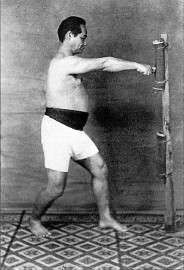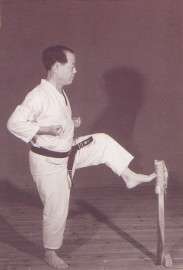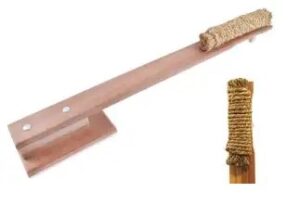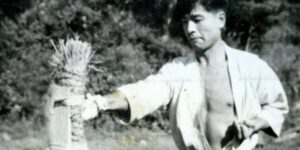The Striking Post, a Symbol of Tradition and Strength in Okinawan Martial Arts.

The Makiwara (巻藁), also known as the punching board, is a traditional training tool used in various styles of Karate. It finds its roots in Okinawan martial arts, it is one form of hojo undō, a method of supplementary conditioning used by Okinawan martial artists. It is primarily used to develop striking power, accuracy, and conditioning of the hands, wrists, and forearms. The history of the Makiwara dates back many centuries and is closely tied to the development of Karate as a martial art.
The term “Makiwara” consists of two Japanese words: “maki 巻,” meaning to wrap or wind, and “wara 藁,” referring to straw. Thus, “Makiwara” can be translated as “wrapped straw.” This name accurately describes the construction of the training tool, which typically involves wrapping a wooden post with straw, rope, or padding to create a striking surface.
Age of the Makiwara
Historically, the age of the makiwara dates back centuries in Okinawan martial arts. While pinpointing an exact origin is challenging, it’s believed that the use of the makiwara as a training tool became prevalent during the development of Okinawan karate, which evolved over many generations. However, there is also the possibility that the makiwara is of a more recent date. Former karate masters such as Sokon Matsumura, Kōsaku Matsumora, and Sakugawa Kanga could very well be the people who introduced the use of this training tool. But again, there is no historical record to prove or disprove this, leaving room for further research or investigation into the origins of the makiwara in karate practice.
Usage in Karate Styles.

The Makiwara has been an integral part of training in Okinawan karate styles, including Shorin-Ryu, Goju-Ryu, and Uechi-Ryu. These styles all have deep roots back to old-style Okinawan todi and have adopted the Makiwara as a core training tool. While the specific methods and techniques may vary slightly between styles, the overall purpose and benefits of Makiwara training remain consistent.
Training on the Makiwara.

The makiwara provides excellent training possibilities, allowing practitioners to train a wide range of techniques, including open and closed hand strikes, kicks, knee strikes, and elbow strikes. When using the Makiwara you must strike from various angles. It’s crucial to pay attention to training both sides of the body, ensuring that the weaker side receives as much focus as the dominant side, maybe even more. However, it’s important not to overuse the Makiwara, as it can potentially cause damage to the fist. Just like with any other training regimen, it’s crucial to avoid any lasting injuries or damage.
Significance in Okinawan Karate.
The makiwara holds profound significance in Okinawan karate, serving as a symbol of dedication, discipline, and perseverance. Regular practice on the makiwara allows practitioners to develop proper technique, power generation, striking accuracy and the development of breathing and Visualization. Moreover, the repetitive nature of striking the makiwara fosters mental focus and resilience, essential qualities for martial artists.
As Sokon Matsumura wrote in the Ten Precepts of karate:
“The use of Makiwara is important for the development of the fists and legs. I advise that you keep your shoulders low (relaxed), open your lungs, take a strong stance, and sink your energy into your Tanden before executing the technique. Hit the Makiwara about 100-200 times with each hand and foot.”
Types of Makiwara Boards.
Over time, the Makiwara has evolved from its original straw and rope construction to more modern variations. Today, there are several types of Makiwara boards available:
Traditional Makiwara.

This type closely resembles the original design, with a wooden base and a padded striking surface. It is still favored by traditionalists and purists who appreciate its historical significance. The wooden base provides stability, and the padded striking surface helps cushion the impact. It allows practitioners to work on different strikes and techniques while maintaining proper posture and conditioning the body.
Padded Makiwara.
These boards have a softer padding on the striking surface, often made of foam or rubber. They are suitable for beginners or those with less conditioned hands, as they provide some cushioning and reduce the risk of injury. The padding helps protect the hands and wrists while still allowing for effective training and technique development.
Wall-mounted Makiwara.
As the name suggests, these Makiwara boards are affixed to a wall, allowing for a more stable and fixed target. They are often made of wood or synthetic materials and are commonly found in modern training facilities. The wall-mounted Makiwara provides less recoil, allowing students to focus on building the endurance of their bones and muscles. It helps perfect posture, and precision, and increases the power of strikes. The board can also be padded for added protection during training, which can be useful for conditioning and strength development. However, training on a bare Makiwara without padding can teach correct techniques more effectively in the long run.
Benefits of Makiwara Training.
Makiwara training has been a topic of debate, with divided opinions on its usefulness. Some argue that it can cause more harm than good, leading to skepticism. However, these arguments may not hold if the board is used properly.
The primary opposition to Makiwara training revolves around the risk of serious injury. Critics suggest that similar results can be achieved by using a punching bag instead. However, this overlooks the fundamental purpose of the Makiwara board. It is not about hitting with maximum force, as that can lead to injuries and inconsistent training.
The essence of Makiwara training lies in developing precision in strikes. By training on a Makiwara board, practitioners can focus their energy on the correct spots, minimizing the chances of injuries in real situations and enhancing the impact of their strikes.

To ensure safety, it is recommended that students gradually progress in their use of Makiwara boards. Starting with a padded board is sensible, as it allows beginners to build durability without excessive strain. With repetitive training, muscles and bones toughen, enabling practitioners to eventually train with wooden Makiwaras. The key is not to push oneself beyond limits to the point of causing injuries but to approach Makiwara training with patience, focus, and discipline.
Despite the debates, Makiwara training offers several benefits for martial artists:
Conditioning.
Regular training on the Makiwara strengthens the muscles, tendons, and bones of the hands, wrists, and forearms. It toughens the skin and enhances resistance to impact.
Striking Power.
The resistance provided by the Makiwara helps develop greater striking power, enabling practitioners to generate force more efficiently and effectively.
Accuracy and Precision.
The Makiwara provides a focused target, allowing practitioners to refine their striking techniques and improve accuracy.
Technique Development.
Makiwara training emphasizes correct body alignment, weight transfer, and proper form, enabling practitioners to fine-tune their technique and establish a strong foundation for their strikes.
Mental Focus.
Training on the Makiwara demands concentration, discipline, and focus, fostering mental resilience and enhancing the mind-body connection.
Chinese inspiration!
While the Makiwara is commonly associated with Japanese martial arts, particularly karate, there are similar training tools and practices in Chinese martial arts that serve comparable purposes. One such tool is the “Iron Palm Bag” used in Iron Palm Training (Tiě Shā Zhǎng), a method practiced in various styles of Chinese Kung Fu. Therefore, it’s possible that the development of the “Makiwara” was influenced by Chinese martial arts techniques and potentially adopted as a training aid by early karate instructors.
In conclusion, while there are differing opinions on Makiwara training, understanding the proper usage and purpose of the board can address concerns of potential harm. With patience, focus, and discipline, practitioners can reap the conditioning, striking power, accuracy, precision, technique development, and mental focus benefits associated with Makiwara training.
It’s important to note that Makiwara training should be approached with caution and under the guidance of a qualified instructor. Proper technique and gradual progression are essential to prevent injuries and maximize the benefits of training on the Makiwara.
Good makiwara training to everybody, and thanks for reading.
Gert

Your dedication to providing high-quality content is truly commendable.
Hi Adrian
Thanks a lot for those nice words.